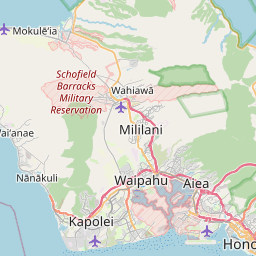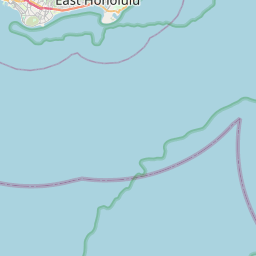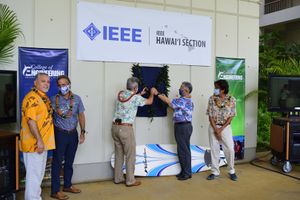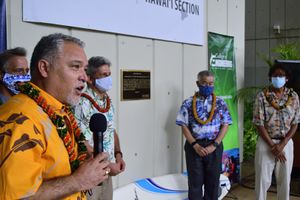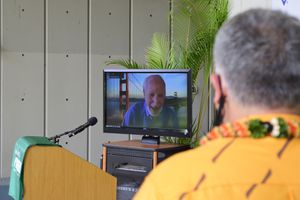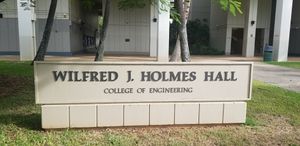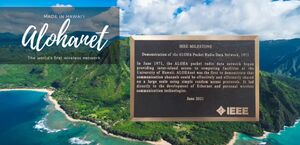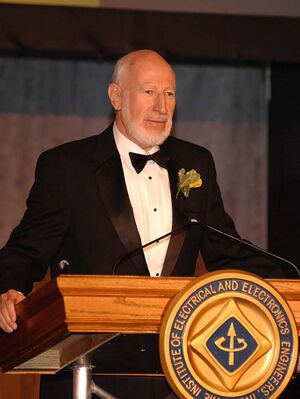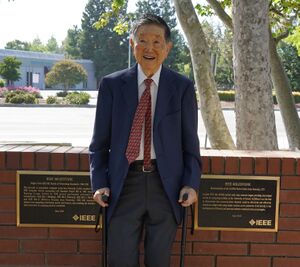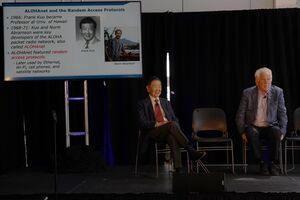Milestones:Demonstration of the ALOHA Packet Radio Data Network, 1971
Title
Demonstration of the ALOHA Packet Radio Data Network, 1971
Citation
In June 1971, the ALOHA packet radio data network began providing inter-island access to computing facilities at the University of Hawaii. ALOHAnet was the first to demonstrate that communication channels could be effectively and efficiently shared on a large scale using simple random access protocols. It led directly to the development of Ethernet and personal wireless communication technologies.
Street address(es) and GPS coordinates of the Milestone Plaque Sites
- Site 1: 2540 Dole Street, Honolulu, Hawaii 96822 US (GPS: 21.296747, 157.815987)
- Site 2: Computer History Museum, 1401 N. Shoreline Blvd, Mountain View, CA 94043 US, (GPS: 37.414757, -122.077679)
Details of the physical location of the plaque
- Site 1: On an exterior wall between 2 pillars on the long side of Holmes Hall facing Dole St., in line with a pedestrian walk signal on Dole St.; this is the College of Engineering Building on the campus of the University of Hawaii at Manoa
- Site 2: On the inside face of the front patio brick wall, near the museum's Main Entrance
How the plaque site is protected/secured
- Site 1: Campus security; 24/7 access
- Site 2: Building security; 24/7 access
Historical significance of the work
ALOHAnet (aka ALOHA System) was the first to connect computers via radio communications and it introduced the computing world to random access protocols.
The development of the Aloha System project at the University of Hawaii beginning in the late 1960s provides historical insight into a variety of wireless data network applications at the start of the 21st century. In 1971 the Aloha System established and operated a UHF terrestrial data network (ALOHAnet) within the state of Hawaii. In 1973 the Aloha System used a VHF transponder in an experimental NASA satellite (ATS-1) to demonstrate an international satellite data network (PacNet) connecting NASA in California and five universities in the United States, Japan, and Australia. Also, in 1973 the Aloha System pioneered the unconventional use of a conventional commercial Comsat channel to link the ALOHAnet and PacNet to ARPANet in the continental United States. ALOHAnet within Hawaii and PacNet covering the Pacific were both based on the use of a random access channel architecture now generally referred to as an ALOHA channel. Today ALOHA channels are utilized in all major mobile networks and in almost all two-way satellite data networks.
The following terminology delineates the three components of the ALOHAnet (aka ALOHA System): ALOHAnet: Comprised of the ALOHA protocol and the ALOHA System; ALOHA System: Comprised of a mainframe computer, remote terminals, terminal connection units, and radio equipment; ALOHA protocol: random access-based packet protocol.
ALOHA acronym was derived from Additive Links On-line Hawaii Area. [The acronym derivation was seldom used and in a short time period ceased to be referenced. ALOHA, ALOHAnet, and the ALOHA System was the references used consistently.]
ALOHAnet (aka ALOHA System) contributed to the advancement in the areas of: communications protocols, computer systems engineering, network engineering., and network access medium (RF).
ALOHAnet (aka ALOHA System) is the worlds’ first packet radio network whereas ARPANET is the world’s first packet switching network.
In June 1971, what the world takes for granted today, ALOHAnet (aka ALOHA System) was the first operational computer network system to establish the following firsts: a) use a random access protocol (ALOHA) that was not extant before; b) use of RF medium (wireless); c) broadcast across a shared access medium. It utilized an experimental UHF frequency granted by the US military since the FCC rejected ALOHA original request. As Dr. Norman Abramson stated he did not envision nor consider commercial use since that meant challenging FCC regulations; FCC regulations at the time did not permit the use of RF spectrum for commercial use and application.
Ubiquitous communications used today (wireless, wired, cellular, computer, mobile, satellite) are based upon the ALOHA protocol and the ALOHA System. ALOHAnet served as the inspiration for the ARPA initiated PRNET project in 1973, which led to packet based radios and even amateur packet based radios. This in turn led to commercial cellular and IEEE 802.11 wireless, along with other non-cellular wireless technologies (e.g., IEEE 802.15.4 Zigbee, Bluetooth). Robert Metcalfe credited ALOHA for his work on the Ethernet and CSMA/CD protocol.
ALOHAnet (aka ALOHA system) introduced a number of firsts in the areas of communications protocols and computer networks: the use of packets in the ALOHA protocol; introduced the use of random access in the ALOHA protocol; introduced the use of shared medium access in the ALOHA network; introduced the use of wireless computer communications (enabled by an experimental UHF frequency).
Prior to the ALOHA protocol, there was no random access protocol and no computer systems engineering, much less software engineering. The oldest packet switching technique, X.25, was created in the 1970s. There was only the field of computer science consisting of mathematics and computer programming. Network engineering simply did not exist: ARPAnet and ALOHAnet (aka ALOHA System) were the pioneers. ALOHAnet (aka ALOHA System) preceded ARPAnet as an operational computer network. More importantly, ALOHAnet utilized RF medium (wireless) rather than a wired medium that was utilized by ARPAnet. The concept of a hub, where all ports broadcast simultaneously the same information simply did not exist during the 1968-1971 timeframe. A specific host could communicate directly with another specific host via a circuit-based connection (satcom or wired). ALOHAnet (aka ALOHA System) was not based upon nor utilized circuit-based connections.
The use of RF as a network access medium also did not exist since there were no networks at the time and the FCC did not permit the use of the radio frequency spectrum for commercial use and application. ALOHAnet (aka ALOHA System) had its initial experimental request for RF spectrum use rejected by the FCC.
Prior to the ALOHA protocol, there was no existing packet-switching or packet-based protocols. The oldest packet switching technique, X.25, was created in the 1970s, well after the ALOHA protocol. X.25 was developed by the common carriers in the 1970s and approved in 1976 by the CCITT, the precursor of the ITU. X.25 was designed for analog telephone transmission over copper wire, in contrast to the ALOHA protocol that while originally designed for RF (i.e., wireless transmission) could also be used for wired transmissions. This was the basis for Bob Metcalfe’s CSMA/CD protocol upon which Ethernet relies upon. It also provided the basis for the CSMA/CA protocol which all wireless protocols rely upon.
The ALOHA protocol was the first random access protocol for accessing a communication medium (wired or wireless) based upon radio packet broadcasting. There was no random access protocol in existence prior to the introduction of the ALOHA protocol. Robert Metcalfe created the Ethernet and the CSMA/CD protocol based on the ALOHA protocol. The ALOHA protocol was the first to be based upon the use of packets and random access. ALOHA protocol mechanism was not packet switching; it was packet broadcasting. The ALOHA technique opened up the entire field of packet broadcasting. When ALOHAnet (aka ALOHA System) became operational in June 1971, the satellite broadcasting field was still new and largely untested. The most significant and promising application of the ALOHA technique was in satellite packet broadcasting. The design of the ARPA Satellite System used a variation of the pure ALOHA technique to make feasible the sharing of a single satellite channel or transponder among a large number of users on a random access basis. The satellite channel can be regarded as a resource which can be shared by many users. It is this resource-sharing enabled by the ALOHA technique or protocol that significantly lowered the cost of data transmission. NASA satellite ATS-1 operationally used the only burst-mode packet broadcasting satellite channel in operation at that time.
It was an experimental RF network since any commercial use or application of the RF frequency spectrum was not permitted at the time by the Federal Communications Commission (FCC). Dr. Abramson stated to IPTO in 1969 that the constraint of one communication channel per user in radio communications seemed unduly limiting. In an ALOHA a single broadcast channel is shared by a number of communicating devices . In the version originally described by Abramson, every device transmits its packets independent of any other device or any specific time . That is, the device transmits the whole packet a t a random point in time ; the device then times out for receiving an acknowledgment. If an acknowledgment is not received, it is assumed that a collision occurred with a packet transmitted by some other device and the packet is retransmitted after a random additional waiting time (to avoid repeated collisions) . Under a certain set of assumptions, Abramson showed that the effective capacity of such a channel is l/(2e) .
ALOHAnet served as the inspiration for the ARPA initiated PRNET project in 1973. Since radio circuits inherently possess a broadcast network topology (i.e., many or all nodes are connected to the network simultaneously), one of the first technical challenges faced in the implementation of packet radio networks was a means to control access to a shared communication channel. Professor Norman Abramson of the University of Hawaii led development of a packet radio network known as ALOHAnet and performed a number of experiments beginning in the 1970s to develop methods to arbitrate access to a shared radio channel by network nodes. This system operated on UHF frequencies at 9,600 baud. From this work the Aloha multiple access protocol was derived. Subsequent enhancements in channel access techniques made by Leonard Kleinrock et al. in 1975 would lead Robert Metcalfe to use carrier sense multiple access (CSMA) protocols in the design of the now commonplace Ethernet local area network (LAN) technology. Over 1973–76, DARPA created a packet radio network called PRNET in the San Francisco Bay area and conducted a series of experiments with SRI to verify the use of ARPANET (a precursor to the Internet) communications protocols (later known as IP) over packet radio links between mobile and fixed network nodes.[1] This system was quite advanced, as it made use of direct sequence spread spectrum (DSSS) modulation and forward error correction (FEC) techniques to provide 100 Kbit/s and 400 Kbit/s data channels. These experiments were generally considered to be successful, and also marked the first demonstration of Internetworking, as in these experiments data was routed between the ARPANET, PRNET, and SATNET (a satellite packet radio network) networks. Throughout the 1970s and 1980s, DARPA operated a number of terrestrial and satellite packet radio networks connected to the ARPANET at various military and government installations.
As stated above, Dr. Norman Abramson deliberately kept the ALOHAnet (aka ALOHA System) as an experimental network to avoid dealing with the FCC. IPTO was instrumental in obtaining permission from the Department of Defense for use of an experimental military UHF frequency since the FCC initially denied ALOHAnet use of any RF frequency spectrum. Amateur Packet Radio began in 1978 when amateur packet radios began experimenting in 1978 after obtaining permission from the Canadian government. In 1980, the FCC granted authorization for US amateurs to transmit ASCII codes via amateur radio. By 1983, TAPR was offering the first TNC available in kit form. Packet radio started becoming more and more popular across North America and by 1984 the first packet-based bulletin board systems began to appear. Packet radio proved its value for emergency operations following the crash of an Aeromexico airliner in a neighborhood in Cerritos, California Labor Day weekend, 1986. Volunteers linked several key sites to pass text traffic via packet radio which kept voice frequencies clear. Commercial operators took note and this led to the rapid development of a number of commercial packet radios systems: MDI (1979); DCS (1984); DRN (1986); Mobitex (1986); ARDIS (1990); CDPD allowed packet data to be carried over AMPS analog cellular telephone networks (1G); GPRS is the packet data facility provided by the GSM cellular telephone network (2.5).
At that time the only conventional method of remote access to a large information processing system was limited to wire communications — either leased lines or dial-up telephone connections. The Hawaiian Islands are comprised of islands separated geographically by water. The University of Hawaii system consists of: a main campus on the island of Oahu; a four-year campus on the island of Hawaii; five two-year community colleges on the islands of Oahu, Kauai, Maui, and Hawaii; and a number of research institutes with operating units distributed throughout the state. All of the University of Hawaii facilities while residing on different islands, are within a radius of 200 miles from the main campus located on the island of Oahu. Linking all these various sites via dial-up telephone lines for computer communications was consuming the lion’s share of the University’s computing budget. The goal of the ALOHAnet (aka ALOHA System) was to connect these geographically separated facilities with relatively low-cost commercially available radio equipment. This civilian need to provide distributed access to a university’s central computing facility obviously resonated with potential military applications. Indeed, upon the operational demonstration of ALOHAnet in June 1971, PRNET came to fruition also under DARPA funding leading further discussed below.
The ALOHA System was the first star, or hub-and-spoke configuration to use shared access medium. Within “the first wireless random access packet-based protocol”, the ALOHA system introduced three (3) firsts: packets; shared access medium; non-licensed use of the RF frequency spectrum. During the 1968-1973 timeframe, computer communications were limited to a single host directly connected via a single wired-circuit or single RF satellite connection to another single specific host. Thus, hub-and-spoke or star network connectivity connections consisted of a single channel on a single circuit. In contrast, ALOHAnet (aka ALOHA System) utilized a two-channel star configuration; it utilized two different RF frequencies for inbound and outbound (analogy here is the uplink and downlink frequencies for today’s cellular networks). The simultaneous use of two different frequencies also allowed full-duplex, another feature of today’s computer and cellular networks; in contrast, IEEE 802.11 Wi-Fi is half-duplex.
In December 1972, ALOHAnet received a call to prepare to install IMP equipment to connect to the ARPAnet via satellite. The University of Hawaii at Manoa IBM 360 mainframe became the first ARPAnet node to be connected via satellite. This allowed connectivity between ALOHAnet and ARPAnet. At this point, the ALOHAnet group turned its attention to using ALOHA channels on a satellite network —PACNET started as the first packet-broadcasting satellite network in 1973; it linked sites in Alaska, Australia, California, Hawaii, and Japan. PACNET utilized the ALOHA protocol.
Inspired by ALOHAnet “ARPA initiated the PRNET project in 1973, funding both theoretical and experimental research. Its goals were outlined by Bob Kahn, namely, to investigate the feasibility of using packet-switched, store-and-forward radio communications to provide reliable computer communications in a mobile environment.” PRNET goal was to address a significantly harder set of problems not addressed by ALOHAnet; specifically, multi-hop communications between mobile vehicles without a central station. PRNET was first established under the auspices of SRI with BBN contributing network technology and Collins creating the Experimental Packet Radios (EPRs), which implemented L-Band spread-spectrum waveforms and supported half-duplex communications at 100 or 400 kilobits/second. A smaller network at BBN was used for software development and testing. Robert Kahn stated, “The ALOHA system was to packet radio like the original timesharing computer was to Arpanet”.
Obstacles (technical, political, geographic) that needed to be overcome
TECHNICAL OBSTACLES Since radio circuits inherently possess a broadcast network topology (i.e., many or all nodes are connected to the network simultaneously), one of the first technical challenges faced in the implementation of packet radio networks was a means to control access to a shared communication channel. Professor Norman Abramson of the University of Hawaii led development of a packet radio network known as ALOHAnet and performed a number of experiments beginning in the 1970s to develop methods to arbitrate access to a shared radio channel by network nodes. This system operated on UHF frequencies at 9,600 baud. From this work the ALOHA multiple access protocol was derived.
“The attitude that we had was that the existing telephone network, which was used by people in those days, was the wrong approach,” Abramson says. “The telephone network was something that was set in place at the end of the 19th century, and we were at the end of the 20th century. We thought that radio communications might be a good way to start on it.” The amazing advance of the ALOHA protocol that is now widely used for nearly all forms of wireless communications is its basic simplicity. . The protocol, in its most concise form, says transmit at will. If interference is detected, retransmit some random time later. What can be simpler? Abramson says, it took three or four months for his team to land on random access protocols — which would allow computers to transmit packets “at will” as soon as they had information to send — as a way to enable this new networking technology. This new way of sending packets meant that transmissions would sometimes collide, but Abramson and his team solved this by allowing terminals to resend failed transmissions.
“In a sense, it’s an obvious thing to do,” Abramson says of random access. “But when you start off on this kind of research project, some of the obvious things don’t appear as obvious as they do a little later.” “First of all, of course, there was no Internet,” he adds. “Second of all, there weren’t even any PCs. The whole digital structure that we’re accustomed to living in today didn’t thrust itself on society and culture. Forty-five years ago, we didn’t realize we needed ALOHA. The concept of mobile communications was many years in the future.” “We realized that what we wanted to do would be fairly important, because people really did need to start connecting computers,” he says. “We just knew that this was a good way to start it, that radio communication was a very important addition to what existed in the world. We thought that what we were doing would be important, but I don’t think any of us thought it would be as important as it turned out to be. It exceeded my wildest expectations.”
FINANCIAL OBSTACLES The most significant obstacle for ALOHANET (aka ALOHA System) was financial funding When Dr. Norman Abramson left Harvard and Stanford to join the University of Hawaii at Manoa Electrical Engineering Department in 1968, there was no funding.
It was fortuitous that DARPA founded Project Themis for FY67, though initial funding was unavailable until the start of Fall Semester of 1967. At that time, DARPA only funded research efforts at top tier universities.
Dr. Norman Abramson got the University of Hawaii funded under Project THEMIS – a Department of Defense program to support developing, second-rank or have-not universities with research funds. At this point in time, Project THEMIS provided the largest amount of research project funds that the University of Hawaii had ever received to fund the ALOHA System.
REGULATORY OBSTACLES One of the reasons was certainly that -- my impression, and I think this was common in a lot of people, was that to do something different with radio communications means that sooner or later, you're going to have to fight the FCC, and I didn't want to do that. I was faculty, a professor, and I truly felt I had no capability in that kind of area and I wouldn't do very well at it, so I really couldn't see myself as trying to shake up the FCC and have them change their rules. That meant that I was thinking of operating under the existing rules, and Aloha wouldn't allow you to operate under existing rules. As a research project, it was quite interesting, but to look further to operational and commercial systems. During that timeframe the FCC did not permit the use of the RF spectrum for commercial use and application. In 1971, no office existed to help the university and the researchers capitalize on the commercial applications of their work, and so the technology was put into the public domain.
GEOGRAPHIC OBSTACLES The goal was to use low-cost commercially available radio equipment to connect users on Oahu and the other Hawaiian Islands with a central time-sharing computer on the main Oahu campus. During that timeframe the only existing method to connect computers was based on dedicated dial-up telephone circuits. This was consuming a significant amount the University of Hawaii budget since their campuses spanned four islands and also included research institutes scattered throughout these four islands (Oahu, Kauai, Maui, and Hawaii). Hawaii relied on underwater telephony circuits to connect the four islands.
Features that set this work apart from similar achievements
Every time you power up your mobile phone or use that phone to establish a voice, SMS, or Internet connection, the very first packet transmitted is sent via an ALOHA random access channel. The importance of the ALOHA channel within all wireless networks has increased as the utilization of such networks for SMS and Internet traffic has increased.
Research in THE ALOHA SYSTEM was divided into two major tasks: (1) to study and develop advanced forms of computer-communications networks using random-access packet switching methods (Task I) and (2) to conduct general studies of multiprocessor system organization centered on the development of the BCC 500 computer (Task II). ALOHAnet used two channels at 407.350 MHz and at 413.475 MHz in the UHF band. The channels operated at 9600 baud. The radio channel, when used in a burst rand-access mode, is known as an ALOHA channel. The ALOHA technique opened up the entire field of packet broadcasting.
As described above, the ALOHA protocol was the first random access protocol and the ALOHA System provided Robert E Kahn the foundation in the development of PRNET to solve a number of significantly challenging problems in both theoretical and experimental research. Robert Metcalfe based his Ethernet and CSMA/CD protocol on the prior research of the ALOHA protocol. Random access schemes dynamically assign radio resources to a large set of users, each with relatively bursty traffic.
Prior to the ALOHA System, a single host could communicate directly via a circuit-based wire or satcom connection only with another specific host. The ALOHA system demonstrated the radio broadcast via a shared medium; in simpler terms, a host could broadcast (i.e., speak to multiple hosts) via a shared medium (i.e., air medium via RF communications). Since the ALOHA protocol was packet-based, it did not require an “always-on” connection and did not require a dedicated analog circuit. The use of packets allowed networks to be viewed as discontinuous, digital systems that transmit data in small packets only when required.
At that time the only conventional method of remote access to a large information processing system was limited to wire communications — either leased lines or dial-up telephone connections. The Hawaiian Islands are comprised of islands separated geographically by water. The University of Hawaii system consists of: a main campus on the island of Oahu; a four-year campus on the island of Hawaii; five two-year community colleges on the islands of Oahu, Kauai, Maui, and Hawaii; and a number of research institutes with operating units distributed throughout the state. All of the University of Hawaii facilities while residing on different islands, are within a radius of 200 miles from the main campus located on the island of Oahu. The goal of the ALOHAnet (aka ALOHA System) was to connect these geographically separated facilities with relatively low-cost commercially available radio equipment.
Project THEMIS was established by the Department of Defense to fund research to “the improvement of centers that existed but were not the top producers in the particular field of endeavor”. Dr. Norman Abramson was instrumental in obtaining Project THEMIS funding during FY 67 with actual research beginning in the fall semester of academic year 1967-1968. The ALOHAnet (aka ALOHA System) was funded under Project THEMIS. Dr. Norman Abramson was instrumental in the IPTO Director, Bob Taylor, approving PROJECT THEMIS funding. A 1969 IPTO meeting established an important decision for the ALOHA protocol: “To directly transmit user information in a single high speed packet burst, now known as an ALOHA channel was made. That is, every terminal would transmit its data to the host using the same radio channel. If collisions occurred, a terminal would receive an acknowledgement and would re-transmit. No terminal had its own dedicated broadcast channel: all terminals would use the same channel.”
In an ALOHA a single broadcast channel is shared by a number of communicating devices. In the version originally described by Abramson, every device transmits its packets independent of any other device or any specific time . That is, the device transmits the whole packet at a random point in time; the device then times out for receiving an acknowledgment . If an acknowledgment is not received, it is assumed that a collision occurred with a packet transmitted by some other device and the packet is retransmitted. after a random additional waiting time (to avoid repeated collisions) . Under a certain set of assumptions, Abramson showed that the effective capacity of such a channel is l/(2e) .
ALOHAnet was asymmetric consisting of remote terminals connected to a central computing facility. Traffic on the outgoing ALOHA channel from the main central facility to the remote terminals was handled differently from traffic on the inbound ALOHA channel to the main central facility from the remote terminals. This approach was chosen to allow each terminal to have access of the full speed of the ALOHA channel rather than dividing the channel up into small, slow segments for each terminal. This randomness was the key feature of ALOHAnet because the main reason for packet loss was too many terminals talking all at once.
At the time, there was a lot of synergy between ARPANET and ALOHAnet; both were the only networks at the time, and both were funded by DARPA. ARPANET became the world’s first packet switching network. ALOHAnet became the worlds’ first packet radio network.
ALOHAnet built their own “Menehune” to handle packets in and out of the mainframe. “Menehune” was inspired by ARPAnet’s Interface Message Processors (IMPs). Both IMPs and Menehune were necessary to handle the asymmetry between the mainframe and the remote terminals. ALOHAnet became operational in June 1971 with a Menehune installed at the University of Hawaii at Manoa main campus and its first remote terminal in Abramson’s home about a mile from the university. By the end of 1971, there was connectivity to four remote terminals and soon thereafter, connectivity was provided to several hundred users. The development/advancement of the radio equipment were crucial to reaching the outlying islands of Kauai, Maui, and Hawaii from the main University of Hawaii campus located on Oahu.
Significant references
Author: Major Vern D. Calloway, Jr. Project Themis 10 U.S.A.F JAG L. Rev. 29 (1968) https://heinonline.org/HOL/LandingPage?handle=hein.journals/airfor10&div=25&id=&page=
Author: Norman Abramson THE ALOHA SYSTEM—Another alternative for computer communications AFIPS ’70 (Fall): Proceedings of the November 17-19, 1979, fall joint computer conference November 1970. Pages 281-285. https://doi.org/10.1145/1478502 (link generates an error message) https://www.clear.rice.edu/comp551/papers/Abramson-Aloha.pdf
Author: Lawrence G Roberts ALOHA PACKET SYSTEM WITH AND WITHOUT SLOTS AND CAPTURE ARPA Satellite System Note 8 on June 26, 1972 https://disco.ethz.ch/alumni/pascalv/refs/rn_1975_roberts.pdf
Author: Norman Abramson Packet Switching with Satellites AFIPS Conference Proceedings, Volume 42, 1973, pp. 695-702 DOI: 10.1109/AFIPS.1973.110 https://www.computer.org/csdl/proceedings-article/afips/1973/50810695/12OmNCcbEad
Author: Norman Abramson Final Technical Report, October 11, 1974 “THE ALOHA SYSTEM” https://apps.dtic.mil/dtic/tr/fulltext/u2/a008865.pdf
Authors: R. Binder, N. Abramson, F. Kuo, A. Okinaka, D. Wax ALOHA packet broadcasting – A retrospect Publication: AFIPS ’75: Proceedings of the May 19-22, 1975, National Computer Conference and Exposition May 1975 Volume:1, Pages: 203-215 DOI Bookmark: 10.1145/1499949.1499985 https://dl.acm.org/doi/10.1145/1499949.1499985 https://apps.dtic.mil/dtic/tr/fulltext/u2/a122775.pdf Also listed as the following: A. Okinaka, D. Wax, N. Abramson, R. Binder and F. Kuo, "ALOHA packet broadcasting - A retrospect," in Managing Requirements Knowledge, International Workshop on, ANAHEIM, 1975 pp. 203. doi: 10.1109/AFIPS.1975.17 https://doi.ieeecomputersociety.org/10.1109/AFIPS.1975.17
Authors: J. Burchfiel, R. Tomlinson and M. Beeler Functions and Structure of a Packet Radio Station AFIPS Conference Proceedings, Volume 44, 1975, AFIPS Press, Montvale, NJ https://www.computer.org/csdl/proceedings-article/afips/1975/50830245/12OmNqAU6Df
Author: R.E. Kahn The Organization of Computer Resources into a Packet Radio Network Managing Requirements Knowledge, International Workshop on, ANAHEIM, 1975, Volume 1, p. 177 DOI: 10.1109/AFIPS.1975.140 https://doi.ieeecomputersociety.org/10.1109/AFIPS.1975.140
Author: Darryl E. Rubin Army Packet Radio Network Protocol Study SRI International, November 1977 https://apps.dtic.mil/dtic/tr/fulltext/u2/a129742.pdf
Authors: Robert E. Kahn, Steven A. Gronemeyer, Jerry Burchfiel, Ronald C. Kunzelman Advances in Packet Radio Technology Proceedings of the IEEE, vol. 66, no. 11, November 1978, pages 1468-1498 https://ieeexplore.ieee.org/abstract/document/1455420
Authors: John Schoch and Larry Stewart Internet Meeting Notes – 10, 11, 12 & 13 September 1979, Internet Experiment Note (IEN) 121, October 25, 1979 https://en.wikipedia.org/wiki/PRNET https://wikimili.com/en/PRNET
Author: Franklin F. Kuo Computer Networks – The ALOHA System. 1981; DOI: 10.6028.jres.086.027 JOURNAL OF RESEARCH of the National Bureau of Standards Vol. 86, No. 6, November-December 1981 http://ccr.sigcomm.org/archive/1995/jan95/ccr-9501-kuo.pdf https://www.semanticscholar.org/paper/Computer-Networks--The-ALOHA-System.-Kuo/45c20ef844080c6bca184edd3eeb0fbd9f7c08eb
Author: N. Abramson Development of the ALOHAnet IEEE Transactions on Information Theory, vol. 31, no. 2, pp. 119-123, March 1985 DOI: 10.1109/TIT.1985.1057021 https://ieeexplore.ieee.org/document/1057021
Author: James Pelkey Entrepreneurial Capitalism and Innovation: A History of Computer Communications 1968-1988 Chapter 6; Networking : Diffusion 1973-1979; Networking Protocols and Local Area Networks http://www.historyofcomputercommunications.info/Book/6/6.2-PacketRadioRobert%20Kahn-72-74.html
Author: James Pelkey Entrepreneurial Capitalism and Innovation: A History of Computer Communications 1968-1988 Chapter 4 Arpanet: 1969-1972 The Beginnings of Computer Networks http://www.historyofcomputercommunications.info/Book/4/4.10-ALOHANETNormAbramson-66-72.html
Computer History Museum Interview of Norman “Norm” Abramson Interviewed by: James L. Pelkey Recorded: October 13, 1988 Menlo Park,California http://archive.computerhistory.org/resources/access/text/2013/05/102746645-05-01-acc.pdf
Aloha and PRNET https://en.wikipedia.org/wiki/Packet_radio
Author: N. Abramson Fundamentals of packet multiple access for satellite networks IEEE Journal on Selected Areas in Communications, Volume: 10, Issue: 2, Feb. 1992, pp. 309-319 DOI: 10.1109/49.126982 https://ieeexplore.ieee.org/document/126982
JPL’s Wireless Communication Reference Website; 1993; 1995 Chapter: Network Concepts and Standards http://www.wirelesscommunication.nl/reference/chaptr01/dtmmsyst/pr.htm
JPL’s Wireless Communication Reference Website; 1993; 1995 Chapter: Data Networks http://www.wirelesscommunication.nl/reference/chaptr06/randacc.htm
Editors: Arogyaswami Paulraj; Vwani Roychowdhury; Charles D. Schaper Communications, Computation, Control, and Signal Processing. Kluwer Academic Publishers; 1997 Packet Radio Multiple Access, pp. 129-140 DOI: 10.1007/9780104615-6281-8 https://link.springer.com/chapter/10.1007/978-1-4615-6281-8_5
Authors: M. Schwartz and N. Abramson The ALOHAnet - surfing for wireless data [History of Communications] IEEE Communications Magazine, vol. 47, no. 12, pp. 21-25, Dec. 2009 DOI: 10.1109/MCOM.2009.5350363 https://ieeexplore.ieee.org/document/5350363
Authors: Shikha Badgotya & Prof. Deepti Rai A Survey on ALOHA Protocol for IoT Based Applications Alpine Institute of Technology, Ujjain, India International Journal of Engineering Sciences & Research Technology DOI: 10.5281/zenodo.1246995 http://www.ijesrt.com/issues%20pdf%20file/Archive-2018/May-2018/36.pdf
Statement of Support - Robert Metcalfe
https://en.wikipedia.org/wiki/ALOHAnet
https://www.cybertelecom.org/notes/internet_history70s.htm
http://certmag.com/alohanet-the-worlds-first-wireless-lan/
https://smartermsp.com/tech-time-warp-say-aloha-to-the-first-wireless-network/
https://www.slideshare.net/nwrusa/history-of-wireless-networking
https://www.youtube.com/watch?v=y72gYcQeais YouTube link addressing ALOHAnet (in Chinese)
https://www.youtube.com/watch?v=vLxEZtl1iAQ (in Hindi)
https://www.youtube.com/watch?v=y72gYcQeais (in Chinese)
http://www-ee.eng.hawaii.edu/events/events.php?evt=15
https://exhibits.stanford.edu/oral-history/about/other-oral-history-projects
https://www.computerhistory.org/collections/catalog/102746645
https://pdfs.semanticscholar.org/21bd/2e6d6630948af1cb6b162d396696c1bd8e10.pdf
Supporting materials
See references
Dedication ceremony
Map
